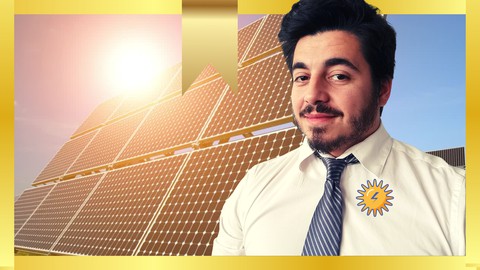
Solar Energy beginner to advanced.SolarPV System Design 2023
Solar Energy beginner to advanced.SolarPV System Design 2023, available at $69.99, has an average rating of 4.34, with 127 lectures, 7 quizzes, based on 386 reviews, and has 1578 subscribers.
You will learn about Learn Solar Energy Fundamentals Design On Grid Solar Energy Systems. Size On Grid Solar Systems and learn about each component of a solar energy system Solar Energy Systems: begginer to advanced. On Grid Photovoltaic Solar System. Solar Energy Fundamentals: solar energy, energy & power, irradiance, units, etc. Peak Sun Hours, Standard Test Conditions (STC), I-V Curves, Performance Curves and more. The Solar Cell: the basic unit of the Solar System. How it works, how it's manufactured, the most popular types and more. The Phovoltaic Effect: the mechanism used to generate electricity from the sunlight. Polycrystalline, monocrystalline and thin film cells. From the solar cell to the solar panel: how it's made, diagrams, how it works, components, and more. The Solar Panel: The most popular and commercially available solar panels. Pros and Cons. Solar Panels: curves, the datasheet, technical parameters, characteristics, construction, junction box, diodes, wiring of the cells, effects of shading and more Temperature coefficient adjustments on solar panels. Packaging, mechanical characteristics and more. The On Grid Inverter:How it works, characteristics, electrical parameters, datasheet, types of on grid inverters and it's pros and cons, how to size and select Wiring & Conduits: the different types, where to use each one, how to size and select them, pros and cons. Wiring diagrams. One-Wire diagram of an on grid transformerless inverter. Protection devices: fuses, SPD's, circuit breakers, RCD's. Characteristics, how they work, how to size and select them. Wiring diagrams. The Combiner box, the wiring and components inside the combiner box. Mounting Structures: the most popular types of structures available in the market. The pros and cons of each type, commercial tips, and more From the components to the system: how the PV Solar System works. How it's wired, how to put all the components together to make the PV System. One-wire Diagram of the PV system, with the protection devices, PV array, on grid inverter, combiner boxes, wiring, conduits, etc. Sizing and design of the Solar PV System: Getting the solar irradiance for free. Import data to the excel we developed to calculate the energy generation. Step by Step sizing a PV Solar System with an example. Optimizing the PV System: the optimal tilt and orientation, calculating the interrow spacing of the PV array, using the sun chart diagram. Super Bonus 1: get our excel files to calculate the energy generation , energy balance and a lot more of data. Temperature corrections using our spreadsheets. Correct sizing and adjustments based on temperature and recommended losses and voltage drops on the wiring. Sizing the PV array, the On Grid Inverter, the concept of clipping, sizing the wiring and conduits, selecting the protection devices, and estimating balances Super Bonus 2: excel spreadsheet to calculate the cost of the PV system, the energy consumption, and more. Financial: how to calculate the payback period, the cost of the PV system. Estimating the savings on the energy bill, commercial tips when selling a PV system. Financial 2: estimating the payback period the master's way: the NET PRESENT VALUE or NPV method. Super Bonus 3: excel file to calculate the cashflows, the payback period, the return on investment, the savings, the discount cash flow, and more. This course is ideal for individuals who are Entrepreneurs or Installers or Solar Energy Professionals or Engineers or People that want to start a business on the solar energy industry or Electricians or People that want to become a installer of residential or commercial solar energy systems or People that want to learn more about how renewable energy works (SOLAR ENERGY) It is particularly useful for Entrepreneurs or Installers or Solar Energy Professionals or Engineers or People that want to start a business on the solar energy industry or Electricians or People that want to become a installer of residential or commercial solar energy systems or People that want to learn more about how renewable energy works (SOLAR ENERGY).
Enroll now: Solar Energy beginner to advanced.SolarPV System Design 2023
Summary
Title: Solar Energy beginner to advanced.SolarPV System Design 2023
Price: $69.99
Average Rating: 4.34
Number of Lectures: 127
Number of Quizzes: 7
Number of Published Lectures: 126
Number of Published Quizzes: 7
Number of Curriculum Items: 134
Number of Published Curriculum Objects: 133
Original Price: $44.99
Quality Status: approved
Status: Live
What You Will Learn
- Learn Solar Energy Fundamentals
- Design On Grid Solar Energy Systems.
- Size On Grid Solar Systems and learn about each component of a solar energy system
- Solar Energy Systems: begginer to advanced.
- On Grid Photovoltaic Solar System.
- Solar Energy Fundamentals: solar energy, energy & power, irradiance, units, etc.
- Peak Sun Hours, Standard Test Conditions (STC), I-V Curves, Performance Curves and more.
- The Solar Cell: the basic unit of the Solar System. How it works, how it's manufactured, the most popular types and more.
- The Phovoltaic Effect: the mechanism used to generate electricity from the sunlight.
- Polycrystalline, monocrystalline and thin film cells.
- From the solar cell to the solar panel: how it's made, diagrams, how it works, components, and more.
- The Solar Panel: The most popular and commercially available solar panels. Pros and Cons.
- Solar Panels: curves, the datasheet, technical parameters, characteristics, construction, junction box, diodes, wiring of the cells, effects of shading and more
- Temperature coefficient adjustments on solar panels. Packaging, mechanical characteristics and more.
- The On Grid Inverter:How it works, characteristics, electrical parameters, datasheet, types of on grid inverters and it's pros and cons, how to size and select
- Wiring & Conduits: the different types, where to use each one, how to size and select them, pros and cons. Wiring diagrams.
- One-Wire diagram of an on grid transformerless inverter.
- Protection devices: fuses, SPD's, circuit breakers, RCD's. Characteristics, how they work, how to size and select them. Wiring diagrams.
- The Combiner box, the wiring and components inside the combiner box.
- Mounting Structures: the most popular types of structures available in the market. The pros and cons of each type, commercial tips, and more
- From the components to the system: how the PV Solar System works. How it's wired, how to put all the components together to make the PV System.
- One-wire Diagram of the PV system, with the protection devices, PV array, on grid inverter, combiner boxes, wiring, conduits, etc.
- Sizing and design of the Solar PV System: Getting the solar irradiance for free. Import data to the excel we developed to calculate the energy generation.
- Step by Step sizing a PV Solar System with an example.
- Optimizing the PV System: the optimal tilt and orientation, calculating the interrow spacing of the PV array, using the sun chart diagram.
- Super Bonus 1: get our excel files to calculate the energy generation , energy balance and a lot more of data.
- Temperature corrections using our spreadsheets. Correct sizing and adjustments based on temperature and recommended losses and voltage drops on the wiring.
- Sizing the PV array, the On Grid Inverter, the concept of clipping, sizing the wiring and conduits, selecting the protection devices, and estimating balances
- Super Bonus 2: excel spreadsheet to calculate the cost of the PV system, the energy consumption, and more.
- Financial: how to calculate the payback period, the cost of the PV system. Estimating the savings on the energy bill, commercial tips when selling a PV system.
- Financial 2: estimating the payback period the master's way: the NET PRESENT VALUE or NPV method.
- Super Bonus 3: excel file to calculate the cashflows, the payback period, the return on investment, the savings, the discount cash flow, and more.
Who Should Attend
- Entrepreneurs
- Installers
- Solar Energy Professionals
- Engineers
- People that want to start a business on the solar energy industry
- Electricians
- People that want to become a installer of residential or commercial solar energy systems
- People that want to learn more about how renewable energy works (SOLAR ENERGY)
Target Audiences
- Entrepreneurs
- Installers
- Solar Energy Professionals
- Engineers
- People that want to start a business on the solar energy industry
- Electricians
- People that want to become a installer of residential or commercial solar energy systems
- People that want to learn more about how renewable energy works (SOLAR ENERGY)
Hello solar friends!! Now we are more than 3100 students worldwide! thank you for this! This shows the quality and content of the course! Visit my profile for more courses like this one 🙂
Thank you so much for your interest in the COMPLETE SOLAR ENERGY COURSE with 119 lectures and extra downloadable resources to help you design, size, and price your solar system!
In this course, you are going to learn from the basics to the more complex subjects on solar energy.
You are going to learn in-depth and intensive content on solar energy.
This is not just a regular course, it’s complete, intensive, and practical, focused on both technical and commercial sides of solar energy.
Solar Energy is growing exponentially and is growing non-stop, it has already created thousands of jobs in the world. It is getting more complex and more knowledge is needed to differentiate yourself in the industry to land a job or to start your own company.
In this course, you will get A LOT of content and knowledge about solar energy and the industry. Including how to design and size a PV System.
I’m a mechanical engineer and I’ve been working in solar energy for more than 7 years, both in the technical and in the commercial and business development side of the industry.
I have a great overview of both sides and I focused on both in this course. That’s why also with the technical information, I’ll be talking about commercial tips during the lectures to help you understand how to see the business and where to stand when selling or selling a PV system.
In this course, we also have a financial section in which we learn how to estimate the PAYBACK period of the PV system using the NET PRESENT VALUE method, a method used on investment analysis not only on solar but in many other industries to analyze an investment.
The approach of this course is to go from the components to the system, this means, we’ll start learning each component of the system separately, and then after we understand how each component works, we’ll see the system working as a whole, how each component work on the system and how the system works altogether.
So there we go, an in-depth, complete course on on-grid solar photovoltaic systems, prepared in a very easy to learn methodology, from the components to the system, step by step, focused on both technical and commercial skills.
You will get access to download the excels that we developed to help you calculate the payback period, the solar energy generation of your PV system for different tilts and we show you how to import the irradiance for any location, the energy consumption of your location, the price per kWp of the system that you are quoting and more.
Enroll in our course now! Join the green revolution and become part of the industry!
The goal is to add more value for you and to spread the green revolution, we are firm believers that the world needs clean energy, and at the same time this has to be sustainable
We need more people to join to cover what the world needs, that’s why we want you to join and tell your friends about us and to join as well if they are interested in solar energy!
Join the green revolution
You’ll learn in detail about:
-
SOLAR ENERGY FUNDAMENTALS
-
THE SOLAR CELLS
-
THE PHOTOVOLTAIC EFFECT
-
THE SOLAR PANELS
-
INVERTERS
-
PERFORMANCE CURVES
-
DATASHEETS AND ELECTRICAL PARAMETERS
-
WIRING & CONDUITS
-
PROTECTION DEVICES
-
COMBINER BOX
-
STRUCTURES FOR THE SOLAR PANELS
-
DESIGN OF THE PV SYSTEM
-
SIZING OF THE PV SYSTEM
-
IMPORTING DATABASE OF SOLAR IRRADIANCE FOR SIZING THE PV SYSTEMS FOR ANY LOCATION
-
OPTIMIZATION OF THE PV SYSTEM
-
SELECTION OF COMPONENTS
-
PAYBACK PERIOD
-
WIRING DIAGRAMS
-
COMMERCIAL TIPS
For more details on what you’ll learn you can refer to the top of the page or to our index preview.
Course Curriculum
Chapter 1: Presentation of the Course
Lecture 1: Index and how to navigate the Solar Energy Course
Lecture 2: Disclaimer
Chapter 2: Solar Energy History and actual context
Lecture 1: Brief History, Present day and near future expectactions on Solar Energy
Chapter 3: Solar Energy Fundamentals
Lecture 1: Energy & Power
Lecture 2: Energy & Power – Examples
Lecture 3: How does the solar energy reach the earth?
Lecture 4: The Solar Radiation Spectrum
Lecture 5: Review
Lecture 6: Diffuse and Direct Radiation
Lecture 7: Peak Sun Hours
Lecture 8: don't forget to leave a 5 stars review 🙂
Lecture 9: To resume – Solar Energy Fundamentals Section
Chapter 4: The Solar Cell
Lecture 1: The Photovoltaic Effect: electricity from the sunlight
Lecture 2: Why Silicon?
Lecture 3: What is doping?
Lecture 4: The PN Junction
Lecture 5: Important facts about solar cells
Lecture 6: Review
Lecture 7: To resume – Solar Cell Section
Chapter 5: The Solar Panel
Lecture 1: Introduction to the Solar Panel Section
Lecture 2: The On Grid Solar System
Lecture 3: From the Solar Cell to the Solar Panel
Lecture 4: Cell Technologies
Lecture 5: PV Modules Views
Lecture 6: From the Solar Cell to the Solar Array
Lecture 7: Solar Cells Technologies: thin film, poly and monocrystalline cells
Lecture 8: The Polycrystalline Cells
Lecture 9: The Monocrystalline Cells
Lecture 10: Mono vs Poly: visual differences
Lecture 11: Electrical Parameters and STC
Lecture 12: Cell Temperature
Lecture 13: Irradiance (STC)
Lecture 14: Air Mass or AM (STC)
Lecture 15: Review
Lecture 16: The Solar Panel Label
Lecture 17: Voltage of a Solar Panel
Lecture 18: Current and Power of the Solar Panel
Lecture 19: Maximum System Voltage of a Solar Panel
Lecture 20: Overcurrent Protection Devices (OCPD) and Certificates of the Solar Panel
Lecture 21: 36, 60 and 72 Cells Solar Panels
Lecture 22: 60 & 72 Cells Solar Panels
Lecture 23: The Solar Panel Datasheet
Lecture 24: The Warranty Curve
Lecture 25: Mechanical Characteristics and Packaging of the Solar Panel
Lecture 26: Electrical Parameters of Solar Panels
Lecture 27: NOCT
Lecture 28: Temperature Coefficients
Lecture 29: Temperature Coefficients – Example
Lecture 30: I-V Curves of the Solar Panels
Lecture 31: Solar Panels Common Problems
Lecture 32: LID or Light Induced Degradation
Lecture 33: PID or Potential Induced Degradation
Lecture 34: Hot Spots on Solar Panels
Lecture 35: Bypass Diodes on Solar Panels
Lecture 36: Microcracks
Lecture 37: Other Defects on Solar Panels
Lecture 38: Other Types of PV Modules
Lecture 39: Double Glass PV Modules
Lecture 40: Bifacial PV Modules
Lecture 41: Half Cell (HC) PV Modules
Lecture 42: Mono PERC PV Modules
Lecture 43: Self Cleaning PV Modules
Lecture 44: Review
Lecture 45: Advantages of Higher Power Output Solar Panels
Lecture 46: To resume – Solar Panels Section
Chapter 6: The Inverter
Lecture 1: Introduction to the inverter section
Lecture 2: Grounded PV Systems
Lecture 3: Transformerless Inverters (TL)
Lecture 4: Inside the inverter
Lecture 5: Inverters Classification
Lecture 6: Grid Interaction
Lecture 7: How the inverter looks like
Lecture 8: The inverter's datasheet and performance curves
Lecture 9: Review
Lecture 10: The Electrical Parameters of the Inverter
Chapter 7: Wiring, conduits & protection devices
Lecture 1: Introduction to the section
Lecture 2: The DC circuit
Lecture 3: Building & Grounding Wire
Lecture 4: Conduits
Lecture 5: The Combiner Box
Lecture 6: The DC Breaker
Lecture 7: Fuses
Lecture 8: Surge Protection Devices (SPD's)
Lecture 9: Residual Current Device (RCD)
Lecture 10: Wiring Diagram
Lecture 11: Wiring Diagram AC side
Lecture 12: To resume – Wiring, conduits and PD section
Lecture 13: Review
Instructors
-
Marco Donzi
Trader y Solar Energy Business Developer
Rating Distribution
- 1 stars: 7 votes
- 2 stars: 11 votes
- 3 stars: 63 votes
- 4 stars: 155 votes
- 5 stars: 150 votes
Frequently Asked Questions
How long do I have access to the course materials?
You can view and review the lecture materials indefinitely, like an on-demand channel.
Can I take my courses with me wherever I go?
Definitely! If you have an internet connection, courses on Udemy are available on any device at any time. If you don’t have an internet connection, some instructors also let their students download course lectures. That’s up to the instructor though, so make sure you get on their good side!
You may also like
- Best Yoga Instruction Courses to Learn in March 2025
- Best Stress Management Courses to Learn in March 2025
- Best Mindfulness Meditation Courses to Learn in March 2025
- Best Life Coaching Courses to Learn in March 2025
- Best Career Development Courses to Learn in March 2025
- Best Relationship Building Courses to Learn in March 2025
- Best Parenting Skills Courses to Learn in March 2025
- Best Home Improvement Courses to Learn in March 2025
- Best Gardening Courses to Learn in March 2025
- Best Sewing And Knitting Courses to Learn in March 2025
- Best Interior Design Courses to Learn in March 2025
- Best Writing Courses Courses to Learn in March 2025
- Best Storytelling Courses to Learn in March 2025
- Best Creativity Workshops Courses to Learn in March 2025
- Best Resilience Training Courses to Learn in March 2025
- Best Emotional Intelligence Courses to Learn in March 2025
- Best Time Management Courses to Learn in March 2025
- Best Remote Work Strategies Courses to Learn in March 2025
- Best Freelancing Courses to Learn in March 2025
- Best E-commerce Strategies Courses to Learn in March 2025






















